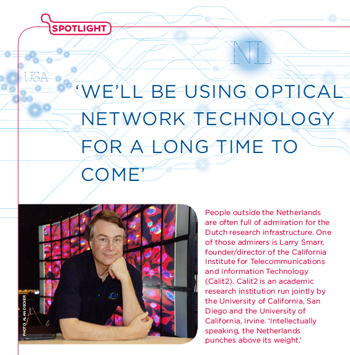Using Optical Network Technology for a Long Time to Come
December 8, 2010 -- People outside the Netherlands are often full of admiration for the Dutch research infrastructure. One of those admirers is Larry Smarr, founder/director of the California Institute for Telecommunications and Information Technology (Calit2). Calit2 is an academic research institution run jointly by the University of California, San Diego and the University of California, Irvine. "Intellectually speaking," notes Smarr, "the Netherlands punches above its weight."
|
In an interview with the Dutch magazine SURF -- which carries news and background information on information and communications technologies for higher education and research, published four times a year by the Utrecht-based SURFnet organization -- Calit2's Smarr told Daphne Riksen that "optical network technology is still at the very start of its life cycle."
Q. Why was Calit2 set up?
A. Ten year ago, the governor of California and the president of the University of California decided to set up four institutes for radically innovative research. If we want to tackle the enormous challenges we’re facing in areas like climate change, food supply, clean drinking water and possible pandemics, we have to get the ‘superheroes’ of multiple disciplines working together. Calit2 is a place for multidisciplinary research that cuts across 24 departments at both universities of San Diego and Irvine. We do that research in buildings equipped with all the latest collaboration technology, for example HD videoconferencing and digital cinema.
The researchers also have access to specialized facilities, like cleanrooms, virtual reality environments and photonics labs. We have a thousand researchers here who collaborate on projects with specialists around the world, such as Professor Cees de Laat at the University of Amsterdam. We also collaborate with companies on research – more than 220 firms in the past four years.
Q. What have you seen change in the past ten years?
A. Since the set up of the four institutions much has changed. First of all, there’s the trend of disciplines increasingly making use of the same infrastructure. Particle physics is a good example. In the 1950s, every lab had its own particle accelerator. In the 1970s, regional particle accelerators started to appear, for example in Stanford, Chicago and Cambridge. And now we have a single accelerator on the planet – the Large Hadron Collider in Geneva – that everyone can use. We've seen the same trend in digital research infrastructures. Every research discipline has gone digital in the past decade. At first, everyone had their own computers, grids and data storage facilities. We’ve now reached the point that all the various disciplines will also be able to share a single digital research infrastructure. That’s an amazing opportunity.
Q. What is the situation like in the United States?
A. Well, every discipline and organisation has its own digital research infrastructure and its own funding. The National Science Foundation has separate systems and networks for each discipline, NASA has its own digital research environment, and so does the Departments of Energy and of Defense. It would be far more efficient to combine them all into a single organisation, of course, the way the Netherlands does with SURF. That’s still a long way off, but I do already see some changes. When I’m in an optimistic mood, I think that in five years’ time we’ll be as far along as the Netherlands is now. Of course, the Netherlands has the advantage of being a small country. That makes coordination a lot easier. But besides that, it’s also way ahead of us in terms of optical network technology. SURFnet and the University of Amsterdam are vital to our international projects. The Netherlands has always been strong in radio astronomy, for that matter. Intellectually speaking, it punches above its weight.
Q. What trends are you anticipating in relation to the digital research infrastructure?
A. In the past ten years, we’ve watched the rise of a very fast, worldwide optical research network, thanks in part to the efforts of optical network pioneers like SUR Fnet. We’ve gradually gotten it properly organised: local optical networks are connected by nodes, and a virtual organisation – GLIF, the Global Lambda Integrated Facility – has been set up where people from around the world collaborate. After all, ideas about progress can come from anywhere. By sharing those ideas within GLIF and coordinating their development, we will continue to have access to best-of-breed technology. Optical network technology is still at the very start of its life cycle. I expect its capacity to increase exponentially, so we’ll be using it for a long time to come.
Related Links
December 2010 SURF Magazine (English edition)
SURFnet
GLIF
Media Contacts
Doug Ramsey, 858-822-5825, dramsey@ucsd.edu

